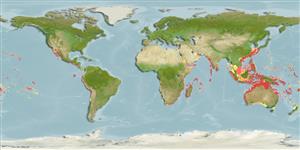Classification / Names
Common names from other countries
Main reference
Size / Weight / Age
Max length : 160 cm TL male/unsexed; (Ref. 9301); common length : 100.0 cm TL male/unsexed; (Ref. 9301)
Environment
Marine; reef-associated; depth range 0 - 132 m (Ref. 58302)
Climate / Range
Tropical, preferred ?; 32°N - 32°S
Distribution
Indo-Pacific: Red Sea and East Africa to Rapa and Easter Island, north to southern Japan, south to Australia and New Zealand (Ref. 5755). Eastern Central Pacific: Mexico to Panama, including offshore islands (Ref. 9301). First record in the Mediterranean was reported (Ref. 36327), and from several countries as of late year 2010. Often misidentified as Fistularia petimba, a reddish or brownish-orange deep-water species with bony plates along dorsal midline.
Countries | FAO areas | Ecosystems | Occurrences | Introductions
Short description
Dorsal
spines
(total): 0;
Dorsal
soft rays
(total): 14-17;
Anal
spines: 0;
Anal
soft rays: 14 - 16;
Vertebrae: 83 - 86. Vertically flattened rather than laterally compressed body. Long whiplike tail filament. Color is green dorsally, grading to silvery white ventrally, with two blue stripes or rows of blue spots on the back. Dorsal and anal fin orange becoming transparent at base. Caudal filament white. Broadly banded at night (Ref. 48635). First four vertebrae fused (Ref. 9826). Branchiostegal rays: 5 (Ref. 36710).
IUCN Red List Status (Ref. 115185)
Threat to humans
Harmless
Human uses
Fisheries: minor commercial; aquarium: commercial
More information
ReferencesAquacultureAquaculture profileStrainsGeneticsAllele frequenciesHeritabilityDiseasesProcessingMass conversion
Tools
Special reports
Download XML
Internet sources
Estimates of some properties based on models
Phylogenetic diversity index
PD50 = 0.6250 many relatives (e.g. carps) 0.5 - 2.0 few relatives (e.g. lungfishes)
Trophic Level
4.3 ±0.7 se; Based on diet studies.
Resilience
Vulnerability
High to very high vulnerability (68 of 100)
Price category
